At least two ships of the Royal Danish Navy have been named Herluf Trolle:
- HDMS Herluf Trolle (1899), a coastal defense ship built in the late 1890s and early 1900s
- HDMS Herluf Trolle (F353), a frigate built in the 1960s
At least two ships of the Royal Danish Navy have been named Herluf Trolle:
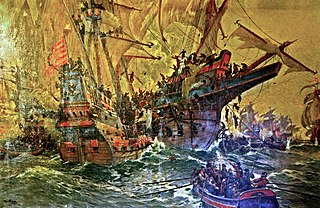
The first battle of Öland took place on 30–31 May 1564 between the islands of Gotland and Öland, between a fleet of Allied ships, the Danes under Herluf Trolle and the Lübeckers under Friedrich Knebel, and a Swedish fleet of 23 or more ships under Jakob Bagge. It was an Allied victory.

Herluf Trolle was a Danish naval hero, Admiral of the Fleet and co-founder of Herlufsholm School, a private boarding school at Næstved on the island of Zealand in Denmark.
Herlufsholm School is a private day and boarding school by the River Suså in Næstved, about 80 kilometers (50 mi) south of Copenhagen. Herlufsholm was founded in 1565 as a boarding school for "sons of noble and other honest men" on the site of a former Benedictine monastery from the 12th century.
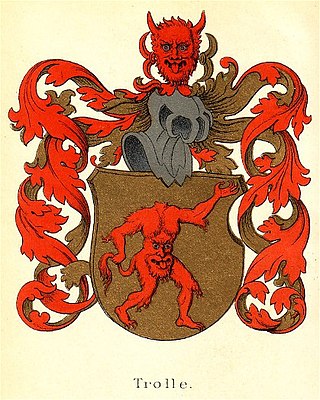
The House of Trolle is the name of a noble family, originally from Sweden. The family has produced prominent people in the histories of Sweden and Denmark since the Middle Ages and is associated with several estates in both countries.

HDMS Peder Skram (F352) was a Peder Skram-class frigate in the Royal Danish Navy which was in use until 1990. It is now docked at Holmen in Copenhagen where it serves as a privately operated museum ship along with the ships of the Royal Danish Naval Museum. The ship is named after Peder Skram, a 16th-century Danish admiral.

The Peder Skram-class frigate was a class of frigates built for the Royal Danish Navy in the period 1964–1967. Only two vessels in this class were ever constructed, Peder Skram (F352) and Herluf Trolle (F353). The ships were named after Danish admirals Peder Skram and Herluf Trolle
Peder Skram, a 16th-century Danish admiral.
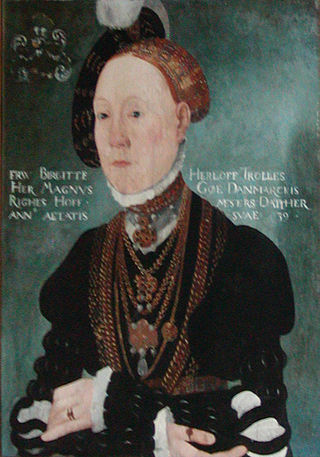
Birgitte Gøye was a Danish county administrator, lady in waiting, landholder and noble, co-founder and principal of Herlufsholm School.

The Herluf Trolle class was a class of coastal defence ships of the Royal Danish Navy. The class comprised Herluf Trolle, Olfert Fischer and Peder Skram.
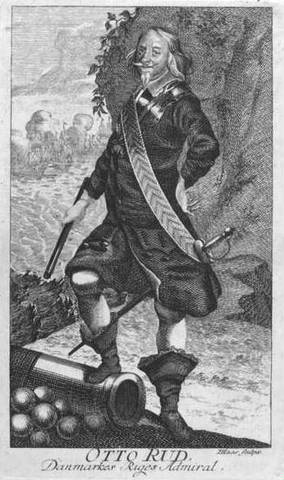
Otte Ruud, born 1520, died 1565, was a Danish-Norwegian admiral during the Northern Seven Years' War, who died in Swedish captivity. He spent his youth in foreign military service, and then held different fiefs from the King. Called up to duty during the war, he at first distinguished himself at land, later becoming a ship's captain, and finally admiral commanding the Danish fleet.

HDMS Havfruen was a frigate of the Royal Danish Navy.

Snedinge is a former manor house and estate located in Slagelse Municipality, Denmark. It has been a farm under Holsteinsborg since 1708. A three-winged complex of farm buildings from circa 1567-1663 have been listed on the Danish registry of protected buildings and places. The main building is from the 1900s but the cellar and foundations date from 1615. It is not listed. Museet for Landbokultur & -Erhverv, a small museum dedicated to the history of agriculture, fishing and crafts in the area, is located in one of the former cow stables.

HDMS Herluf Trolle (F353) was a Peder Skram-class frigate in the Royal Danish Navy which was in use until 1990. The ship is named after Herluf Trolle, a 15th-century Danish admiral.
Trolle is a surname which is common in the Scandinavian countries. People with the surname include:
Herluf is a masculine given name which is common in Scandinavian countries. People with the name include:

Herluf Trolle Land is an area in Peary Land, North Greenland. Administratively it is part of the Northeast Greenland National Park.
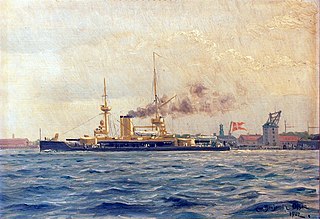
HDMS Herluf Trolle was the lead ship of the Herluf Trolle class of coastal defense ships built for the Royal Danish Navy. The Herluf Trolle class was built in response to a naval construction program in neighboring Imperial Germany. The Danish ships were built in the late 1890s and early 1900s. They were armed with a main battery of two 240 mm (9.4 in) guns and were capable of a top speed of 15.5 knots. Because she was intended to operate as part of a solely defensive naval strategy, Herluf Trolle had a fairly uneventful career. She visited Britain in 1902 to represent Denmark at the coronation of Edward VII and Alexandra. During World War I, Denmark remained neutral and Herluf Trolle was assigned to the defense forces that guarded Danish territorial waters. Sharply reduced naval budgets in the 1920s and 1930s curtailed further activities, and in 1932, she was discarded for scrap.

HDMS Olfert Fischer was the second member of the Herluf Trolle class of coastal defense ships built for the Royal Danish Navy. The Herluf Trolle class was built in response to a naval construction program in neighboring Imperial Germany. The Danish ships were built in the late 1890s and early 1900s. They were armed with a main battery of two 240 mm (9.4 in) guns and were capable of a top speed of 15.5 knots. Because she was intended to operate as part of a solely defensive naval strategy, Olfert Fischer had a fairly uneventful career. She visited Britain in 1911 to represent Denmark at the coronation of George V and Mary. During World War I, Denmark remained neutral and Olfert Fischer was assigned to the defense forces that guarded Danish territorial waters. Sharply reduced naval budgets in the 1920s and 1930s curtailed further activities, and Olfert Fischer saw little activity during this period, apart from testing a reconnaissance aircraft in 1922. She was eventually converted into a target ship and used for tests of aerial bombing of a ship underway in October 1936, before being sold for scrap immediately thereafter.
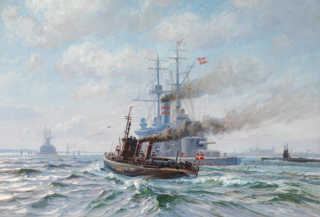
HDMS Peder Skram was the third and final member of the Herluf Trolle class of coastal defense ships built for the Royal Danish Navy. The Herluf Trolle class was built in response to a naval construction program in neighboring Imperial Germany. The Danish ships were built in the late 1890s and early 1900s; Peder Skram was delayed significantly compared to her sisters, and was laid down in 1905, after her two sister ships had already been completed. The ships were armed with a main battery of two 240 mm (9.4 in) guns and were capable of a top speed of 15.5 knots.
At least three ships of the Royal Danish Navy have been named Peder Skram: